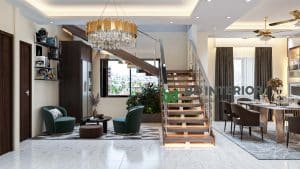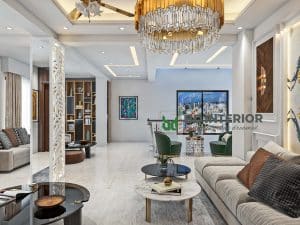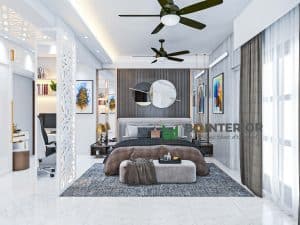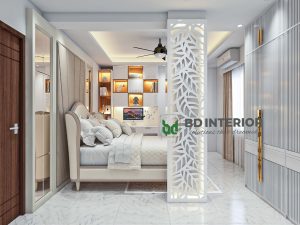Home is more than just a physical structure; it is a place where we find comfort, love, and a sense of belonging. It is our sanctuary, a space that reflects our personality, and a place where we create memories with our loved ones. Home is where we retreat after a long day, where we celebrate our joys, and where we find solace in times of sadness. It is a place of warmth, laughter, and love.

The importance of home interior design cannot be overstated. It goes beyond just making our living spaces look beautiful; it plays a crucial role in enhancing our overall well-being and quality of life. Here are some key reasons why home interior design is so important:
- Personalization: Interior design allows homeowners to personalize their living spaces according to their tastes, preferences, and lifestyle. It helps to create a unique and distinct identity for the home that reflects the personality of the occupants.
- Optimal Space Utilization: A well-designed interior ensures efficient use of space. It maximizes the available space and provides clever storage solutions, making the home more organized and clutter-free.

- Enhanced Functionality: Interior design takes into account the needs and activities of the homeowners. It creates a layout that enhances the functionality of each room, making daily tasks and activities more convenient and enjoyable.
- Improved Comfort and Livability: Thoughtful interior design elements such as comfortable furniture, proper lighting, and temperature control contribute to a higher level of comfort and livability in the home.
- Visual Appeal: Aesthetically pleasing interiors have a positive impact on the mood and well-being of the occupants. The right colors, textures, and decor elements can create a harmonious and inviting atmosphere.
- Increased Property Value: Well-designed interiors can significantly increase the value of a property. Homebuyers are more likely to be attracted to a home that is beautifully designed and well-maintained.

- Better Flow and Connectivity: Interior design ensures a smooth flow and connectivity between different spaces in the home. It creates a seamless transition from one area to another, making the home feel more cohesive and functional.
- Sustainability and Energy Efficiency: Interior design can incorporate eco-friendly materials and energy-efficient solutions, contributing to a more sustainable and environmentally responsible living space.
- Safety and Ergonomics: Interior design takes into account safety considerations and ergonomic principles. It ensures that the home is designed in a way that minimizes the risk of accidents and promotes better posture and comfort.
- Long-term Cost Savings: Investing in good interior design can lead to long-term cost savings. Well-chosen materials and fixtures, as well as energy-efficient solutions, can reduce maintenance and utility costs over time.
- Positive Impression: A well-designed interior leaves a lasting positive impression on guests and visitors. It enhances the overall experience of living in and interacting with the home.
- Emotional Well-being: A thoughtfully designed interior can have a positive impact on the emotional well-being of the occupants. It creates a space that is calming, inspiring, and nurturing, contributing to a better quality of life.

Here are some guidelines and tips for home interior design:
- Understand Your Needs: Before starting the design process, understand your needs and lifestyle. Consider how you use each space and what elements are essential for you and your family.
- Plan the Layout: A well-planned layout is crucial for optimal space utilization. Consider the flow between rooms, and ensure that there is enough space for movement and activities.
- Choose a Theme: Decide on a theme or style that you want to incorporate throughout your home. Whether it’s modern, traditional, minimalist, or eclectic, a cohesive theme will create a harmonious and visually pleasing interior.
- Colors and Textures: Choose a color palette that reflects your personality and complements the theme. Use textures to add depth and interest to the space.
- Lighting: Proper lighting is essential for creating the right ambiance in each room. Incorporate a mix of natural and artificial lighting to enhance the mood and functionality.

- Furniture Selection: Select furniture that fits the scale of the room and aligns with the overall design concept. Invest in comfortable and durable pieces that will stand the test of time.
- Storage Solutions: Incorporate smart storage solutions to keep your home organized and clutter-free. Built-in cabinets, shelves, and hidden storage can maximize space without compromising on aesthetics.
- Art and Decor: Add personality to your home with artwork, decorative pieces, and accessories that reflect your interests and style.
- Flooring and Carpets: Choose flooring materials that are practical and easy to maintain. Area rugs and carpets can add warmth and texture to the space.
- Greenery: Bring nature indoors with indoor plants and greenery. They not only add a touch of freshness but also improve air quality.
- Balance and Proportion: Maintain a sense of balance and proportion in your design. Avoid overcrowding or leaving spaces too empty.
- Sustainable Design: Consider eco-friendly and sustainable materials and practices for a more environmentally responsible home interior.
- Personal Touch: Add personal touches to your home with family photos, mementos, and sentimental items that evoke fond memories.
- Functionality and Safety: Prioritize functionality and safety in your design. Ensure that the layout and furniture placement allow for easy movement and access.
- Seek a Professional interior design company: If you’re unsure about the design process or need expert guidance, don’t hesitate to seek the assistance of professional interior designers like BD INTERIOR. They can help bring your vision to life and ensure a seamless and beautiful home interior.

By following these guidelines and incorporating your personal style, you can create a home interior that is not only aesthetically pleasing but also functional, comfortable, and truly reflects your lifestyle and preferences.
In conclusion, home interior design is not just about aesthetics; it is about creating a functional, comfortable, and inspiring living space that enhances the overall well-being and happiness of the homeowners. It is an investment that adds value to the home and enriches the daily lives of its occupants.